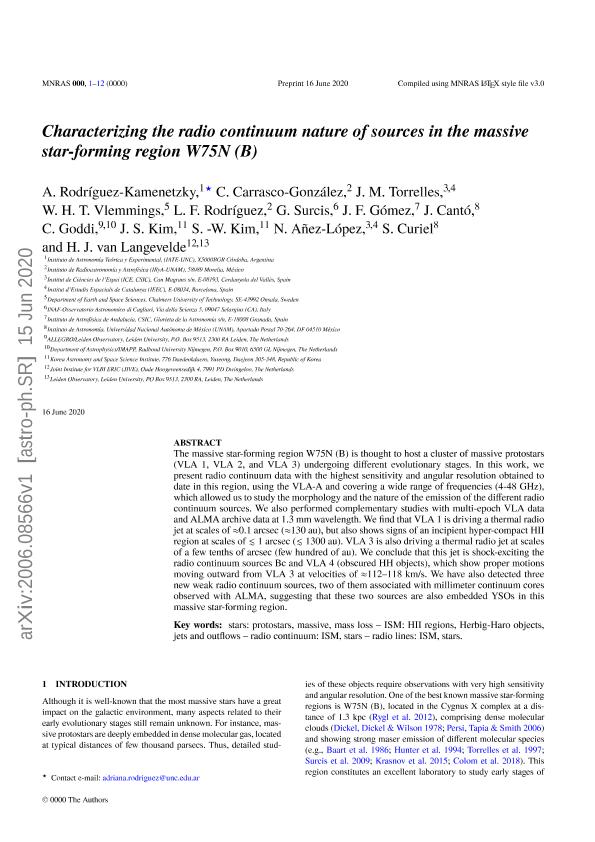Mostrar el registro sencillo del ítem
dc.contributor.author
Rodríguez Kamenetzky, Adriana Raquel

dc.contributor.author
Carrasco-González, Carlos
dc.contributor.author
Torrelles, J. M.
dc.contributor.author
Vlemmings, W. H. T.
dc.contributor.author
Rodríguez, L. F.
dc.contributor.author
Surcis, G.
dc.contributor.author
Gómez, J. F.
dc.contributor.author
Cantó, J.
dc.contributor.author
Goddi, C.
dc.contributor.author
Kim, J. S.
dc.contributor.author
Kim, S. -W.
dc.contributor.author
Añez-López, N.
dc.contributor.author
Curiel, S.
dc.contributor.author
van Langevelde, H. J.
dc.date.available
2021-09-22T18:14:30Z
dc.date.issued
2020-06
dc.identifier.citation
Rodríguez Kamenetzky, Adriana Raquel; Carrasco-González, Carlos; Torrelles, J. M.; Vlemmings, W. H. T.; Rodríguez, L. F.; et al.; Characterizing the radio continuum nature of sources in the massive star-forming region W75N (B); Wiley Blackwell Publishing, Inc; Monthly Notices of the Royal Astronomical Society; 496; 3; 6-2020; 3128-3141
dc.identifier.issn
0035-8711
dc.identifier.uri
http://hdl.handle.net/11336/141210
dc.description.abstract
The massive star-forming region W75N (B) is thought to host a cluster of massive protostars (VLA 1, VLA 2, and VLA 3) undergoing different evolutionary stages. In this work, we present radio continuum data with the highest sensitivity and angular resolution obtained to date in this region, using the VLA-A and covering a wide range of frequencies (4–48 GHz), which allowed us to study the morphology and the nature of the emission of the different radio continuum sources. We also performed complementary studies with multi-epoch Very Large Array (VLA) data and Atacama Large Millimeter Array (ALMA) archive data at 1.3 mm wavelength. We find that VLA 1 is driving a thermal radio jet at scales of ≈0.1 arcsec (≈130 au), but also shows signs of an incipient hypercompact H II region at scales of ≲1 arcsec (≲1300 au). VLA 3 is also driving a thermal radio jet at scales of a few tenths of arcsec (few hundred of au). We conclude that this jet is shock exciting the radio continuum sources Bc and VLA 4 (obscured Herbig–Haro objects), which show proper motions moving outward from VLA 3 at velocities of ≈112–118 km s−1. We have also detected three new weak radio continuum sources, two of them associated with millimetre continuum cores observed with ALMA, suggesting that these two sources are also embedded young stellar objects in this massive star-forming region.
dc.format
application/pdf
dc.language.iso
eng
dc.publisher
Wiley Blackwell Publishing, Inc

dc.rights
info:eu-repo/semantics/openAccess
dc.rights.uri
https://creativecommons.org/licenses/by-nc-sa/2.5/ar/
dc.subject
H II REGIONS
dc.subject
HERBIG–HARO OBJECTS
dc.subject
ISM: JETS AND OUTFLOWS
dc.subject
RADIO CONTINUUM: ISM
dc.subject
STARS: MASSIVE
dc.subject
STARS: PROTOSTARS
dc.subject.classification
Astronomía

dc.subject.classification
Ciencias Físicas

dc.subject.classification
CIENCIAS NATURALES Y EXACTAS

dc.title
Characterizing the radio continuum nature of sources in the massive star-forming region W75N (B)
dc.type
info:eu-repo/semantics/article
dc.type
info:ar-repo/semantics/artículo
dc.type
info:eu-repo/semantics/publishedVersion
dc.date.updated
2021-04-23T16:41:28Z
dc.identifier.eissn
1365-2966
dc.journal.volume
496
dc.journal.number
3
dc.journal.pagination
3128-3141
dc.journal.pais
Reino Unido

dc.journal.ciudad
Londres
dc.description.fil
Fil: Rodríguez Kamenetzky, Adriana Raquel. Consejo Nacional de Investigaciones Científicas y Técnicas. Centro Científico Tecnológico Conicet - Córdoba. Instituto de Astronomía Teórica y Experimental. Universidad Nacional de Córdoba. Observatorio Astronómico de Córdoba. Instituto de Astronomía Teórica y Experimental; Argentina
dc.description.fil
Fil: Carrasco-González, Carlos. Universidad Autónoma de México. Instituto de Radioastronomía y Astrofísica; México
dc.description.fil
Fil: Torrelles, J. M.. Institut de Ciències de L'espai; España
dc.description.fil
Fil: Vlemmings, W. H. T.. Chalmers University of Technology; Suecia
dc.description.fil
Fil: Rodríguez, L. F.. Universidad Autónoma de México. Instituto de Radioastronomía y Astrofísica; México
dc.description.fil
Fil: Surcis, G.. Osservatorio Astronomico di Cagliari; Italia
dc.description.fil
Fil: Gómez, J. F.. Instituto de Astrofísica de Andalucía; España
dc.description.fil
Fil: Cantó, J.. Universidad Autónoma de México. Instituto de Radioastronomía y Astrofísica; México
dc.description.fil
Fil: Goddi, C.. Leiden University. ALLEGRO/Leiden Observatory; Países Bajos
dc.description.fil
Fil: Kim, J. S.. Korea Astronomy and Space Science Institute; Corea del Sur
dc.description.fil
Fil: Kim, S. -W.. Korea Astronomy and Space Science Institute; Corea del Sur
dc.description.fil
Fil: Añez-López, N.. Institut de Ciencies de L´espai ; Consejo Superior de Investigaciones Cientificas;
dc.description.fil
Fil: Curiel, S.. Institut de Ciencies de L´espai ; Consejo Superior de Investigaciones Cientificas;
dc.description.fil
Fil: van Langevelde, H. J.. Leiden University; Países Bajos
dc.journal.title
Monthly Notices of the Royal Astronomical Society

dc.relation.alternativeid
info:eu-repo/semantics/altIdentifier/url/https://academic.oup.com/mnras/advance-article/doi/10.1093/mnras/staa1742/5860292
dc.relation.alternativeid
info:eu-repo/semantics/altIdentifier/doi/http://dx.doi.org/10.1093/mnras/staa1742
Archivos asociados
